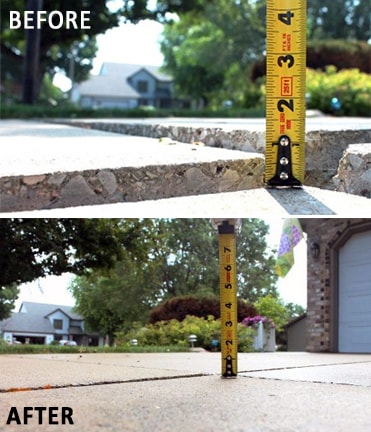Mudjacking is Bit of a Misnomer
The following article is from KansasCity.com by Alan Goforth
Summer Means Homeowners May See More Mudjacking

Though homeowners are finally getting a break as summer nears its end, they might be in for an unpleasant surprise when they take a closer look at their driveways, sidewalks or patios.
“We are looking at a lot more work than we usually do,” said Rob Kramer, owner of KC Pro, a foundation repair company in Kansas City. “Although we do repair work year-round, we generally see more business when it’s dry and the soils have drawn down.”
The always-changing climate in the Kansas City area is tough on concrete, said Perry Hochkammer, owner of Black-Jack Grout Pumps in Rockford, Ill., and president of the American Pressure Grouting and Mudjacking Association.
“Parts of the country with cycles of freezing and thawing always see the most problems,” he said. A cost-effective solution to settling concrete is a simple process with an interesting name — mudjacking. Workers drill 2-inch to 5-inch holes into slabs of concrete that have settled and pump in a mixture that can include topsoil, lime ash, and portland cement. This mixture both fills the voids and raises the slab to its original level. After the surface is leveled, the drill holes are filled with concrete.
Don’t Be Misled
The term “mudjacking” may be a bit misleading, said Dennis Morgan, owner of Pro Foundation Technology Inc., which has locations in Raytown and Columbia. The company was founded in 1978 and has been doing mudjacking since 1990.
“We should use a different term than mudjacking, but that is what most people recognize,” he said. “It should be slab jacking. We don’t use mud anymore but a mixture of lime and portland cement.”
The term made sense when the process was developed nearly four decades ago, Hochkammer said.
“Workers initially used hot asphalt and then switched to a black topsoil blend,” he said. “Over the years, the organic material such as topsoil and mud begins to break down. Now we use more stable materials such as lime ash and portland cement.”
KC Pro uses a slurry of pulverized topsoil and portland cement, said Kramer, who has 17 years of repair experience. The slurry is thickened as needed. Pro Foundation Technology also has been working with a high-density polyurethane on projects for the Missouri and Kansas transportation departments.
“Polyurethane does the same thing but lasts longer,” Morgan said. “It’s very light and doesn’t burden the soil as much. Some homeowners also are starting to use it, although it costs a little more. Smaller holes are required, which is an advantage if you are working on a nice patio, for example.”
Economical Option for Concrete Repair
The slow economy has helped the mudjacking business, with customers finding it more economical to repair rather than replace damaged concrete. “Typically, when the economy is faltering, mudjacking is a good alternative to replacement for municipalities and homeowners on tight budgets,” Hochkammer said. “Mudjacking to raise concrete costs about one-fourth as much as a replacement.” Kramer agrees.
“The economy has not affected our business very much,” he said. “The average cost of a project is $600 to $700, which is much easier to come up with that than $5,000 to $6,000 for replacement.”
As with any type of project, the bigger the problem, the higher the cost. But, Kramer said, “The smaller the pieces of concrete, the more difficult it is to use mudjacking. We can lift the bigger pieces, but the smaller ones will fall out. People need to contact us before the concrete begins breaking into small pieces.”
Indications of sinking concrete are hard to miss. “The most common sign that most people see is a speed bump as they pull into their garage,” Morgan said. It pays to shop around.
Hochkammer said, “The best place to go is the Better Business Bureau. Companies should provide at least three references. My association (www.apgma.com) also can help if you have trouble finding a good local company.”
As summer winds down, local mudjacking businesses urge homeowners to keep a close eye on concrete surfaces. “We will have a lot of calls after this hot weather,” Morgan said. “The Kansas City area is good for business.”
